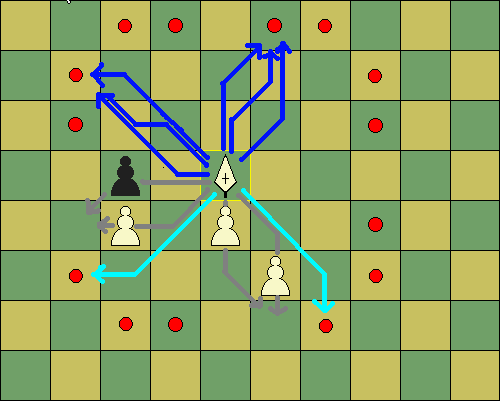
Moves of the Falcon piece
- Lance symbol: location of Falcon
- Red dots: move targets
- Blue arrows: alternative move paths
- Grey arrows: blocked move paths
- Cyan arrows: only open path to given square

Falcon Chess is licenced under U.S. Patent #5,690,334 by George W. Duke
Chess Home Page 10x8 Home Page
Falcon Chess is a game played on a 10x8 board, with a set of normal Chess pieces, moving as they would in orthodox Chess, plus two new pieces: the Falcons. The official rules of Falcon Chess also involve a more liberal form of castling. In the current demo match, this is not implemented though. So castling is as is is usually done on 10x8 boards (e.g. Capablanca Chess): the King moves 3 squares towards the Rook.
Various opening arrays are possible. The current match uses the setup RNBFQKFBNR, because this seems to invite earlier and better participation of the Falcon pieces.
The Falcon is a patented piece, and is the natural complement to the Rook, Bishop, Knight of orthodox Chess. Where the Knight reaches all squares at distance 2 (the 'second ring') that are not cvered by B or R, a Falcon does so for the third ring. So it makes (1,3) or (2,3) steps, for a maximum of 16 destinations.
The technical term for a Falcon would be a (1,3)+(2,3) lame multi-path compound leaper. Leapers are pieces like the Knigth that can only make a single step in any direction, this in contrast to sliders (like Bishop and Rook), which can repeat their steps in the same direction as long as they don't meet an obstruction. The qualification 'lame' refers to the property that a leaper cannot unconditionally jump to its move targets, like the Knight can, but has to follow a path on the board that must be unobstructed. The Horse of Xiangqi (Chinese Chess) is an example of a lame leaper: it moves like a Knight, but cannot go from e2 to f4 if e3 is not empty. And if it is blocked, it cannot capture the blocker.

|
Moves of the Falcon piece
|
The Falcon also needs an unobstructed path to its move target. But it has the choice between three (partly coinciding) paths. As long as one of the paths is unobstructed, it can use that path to reach its destination. This makes it much more difficult to block than the Horse. At least two obstacles are needed to block a Falcon move. This makes pins and discovered threats with Falcons much different in character than with normal sliders. Especially the concept of moving along a pin ray is not so clear-cut, as the pin 'ray' can branch.
The picture above shows a Falcon on a non-empty board, and indicates the squares it can reach (red dots). For some of these (b7 and f8) it indicates the three paths to them by blue arrows. The blocked path to b4 and f2 are indicated by gray arrows; these squares cannot be reached. The square b3 and g2 can be reached, because there still is one open path (indicated by a light-blue arrow) to those. This despite the fact that the other two paths are blocked.
A Falcon captures the same way as it moves.
The Falcon is worth slightly more than a Rook in the opening and middle-game. In the end-game, the Rook seems to get the upper hand, though. Especially if there are Pawns on both wings. The main weakness of the Falcon compared to the Rook in such endings is that the Falcon cannot move and keep a Pawn defended at the same time. This makes it impossible to defend against a Rook, as the latter will position itself to attack both Falcon and Pawn. Thus it must rely on counter-attacking, making use of its forking potential.
Both Rook and Falcon have the ability to checkmate a bare King, on a 10x8 board. (The Rook can do so on boards of any size, but for the Falcon a 16x16 board would be too big to drive the bare King into a corner from any position.) With white to move the KRK and KFK end-games are really 100% won, there is not a single draw position. With black to move, there are of course positions where the bare King can capture an undefended piece to secure a draw. This can happen equally easy to Rook or Falcon.